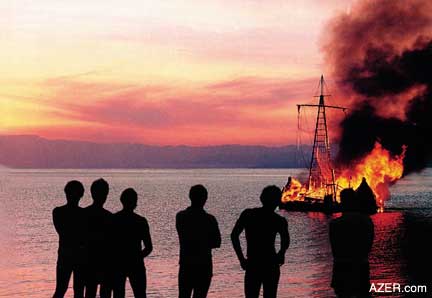Tigris calling Ra

One of my earliest memories is of watching a documentary of a man who had contructed a ship of reeds and along with a multi-national crew sailed it thousands of miles around the world.
I remember the man. He was lithe and tanned, with a straggled mop of blonde hair and a beard. I remember he was on some kind of mission, a personal one and also one with greater significance for mankind.
I remember it was filmed on Super 8 cine film and the saturation of the colours and the scratches and imperfections of the film.
 Most vividly I remember him sat inside his homemade craft, hailing his support team on the radio: "This is Tigris calling Ra, come in Ra. This is Tigris calling Ra, come in Ra."
Most vividly I remember him sat inside his homemade craft, hailing his support team on the radio: "This is Tigris calling Ra, come in Ra. This is Tigris calling Ra, come in Ra."I remember all of these things and often they echo in my head for days.
I discovered today that this documentary was filmed in 1978 - when I was 5 years old.
Today I random googled this phrase and uncovered the whole story.
The Tigris Expedition
Across the Indian Ocean by reed boat (1978)
In ancient times, reed boats were used as vessels in the Mediterranean from the Middle East to the Atlantic coast.
Thor Heyerdahl now became interested in the highly controversial question concerning whether or not there had originally been contact between the three ‘mother’ civilisations in Mesopotamia, Egypt, and the Indus Valley.
In all of these three culturally related regions prehistoric artists had left behind illustrations of the same kind of reed boat on which he himself had crossed the Atlantic Ocean.
Heyerdahl had learnt from the Marsh Arabs in the former Sumerian region of Iraq that the reeds would only retain their buoyancy properties if they were cut in the month of August. Heyerdahl decided to try this, and at the same time experiment with the navigation of a reed ship. His previous sea voyages had been purely drifting voyages.
In 1977, Heyerdahl built his largest reed vessel, 18 m long, where the Euphrates and Tigris rivers meet in the former Mesopotamia, now Iraq. The vessel was named Tigris.
Tigris was constructed of reed bundles lashed together by marsh Arabs under the leadership of the same South American Indians who had built Ra II. Once again Heyerdahl sailed under the flag of the UN, with an international crew of 11 men, of whom 3 were earlier companions from the two Ra voyages: Norman Baker (USA), Yuri Senkevich (USSR), and Carlo Mauri (Italy).
Tigris sailed 6,800 km. First they sailed down Shatt-el-Arab in Iraq to the Persian Gulf and out into the Indian Ocean. Thereafter the voyage took them, via Muscat in Oman, to the Indus Valley in Pakistan, before finally leaving Asia and sailing across the Indian Ocean to Africa.
The 5 month long journey ended in Djibouti at the mouth of the Red Sea. Surrounded by wars on all sides, the expedition’s members decided in April 1978 to burn the vessel. At the same time the expedition’s members also sent a unanimous appeal to the UN asking it to stop arms deliveries to developing countries in the region of the world where the foundations of our own civilisation were laid.
Tigris had, unlike Kon-Tiki and the two Ra boats, sailed to predetermined harbours independent of the wind and current conditions, and lay high enough in the water to be consumed by flames. A popular book and four TV programmes resulted from the expedition.
25 Years Ago
Heyerdahl Burns "Tigris" Reed Ship to Protest War
Story by Betty Blair and Bjornar Storfjell
Above: On April 3, 1978, after their five-month-4,200-mile-oceanic voyage, Thor Heyerdahl (center) and his 10-man crew burn their reed ship Tigris in protest of the wars raging in the Middle East. (Photo by Kon-Tiki Museum, Oslo).
Sadly, in the quarter century that has passed nothing that Thor Heyerdahl hoped to highlight by his journeys has come to pass.

1 Comments:
I remember this guy too! I have the book about the Kon-tiki voyage and remember reading it at a really young age.
Thanks for re-igniting the memory bro!
Aroha,
Matt
Post a Comment
<< Home